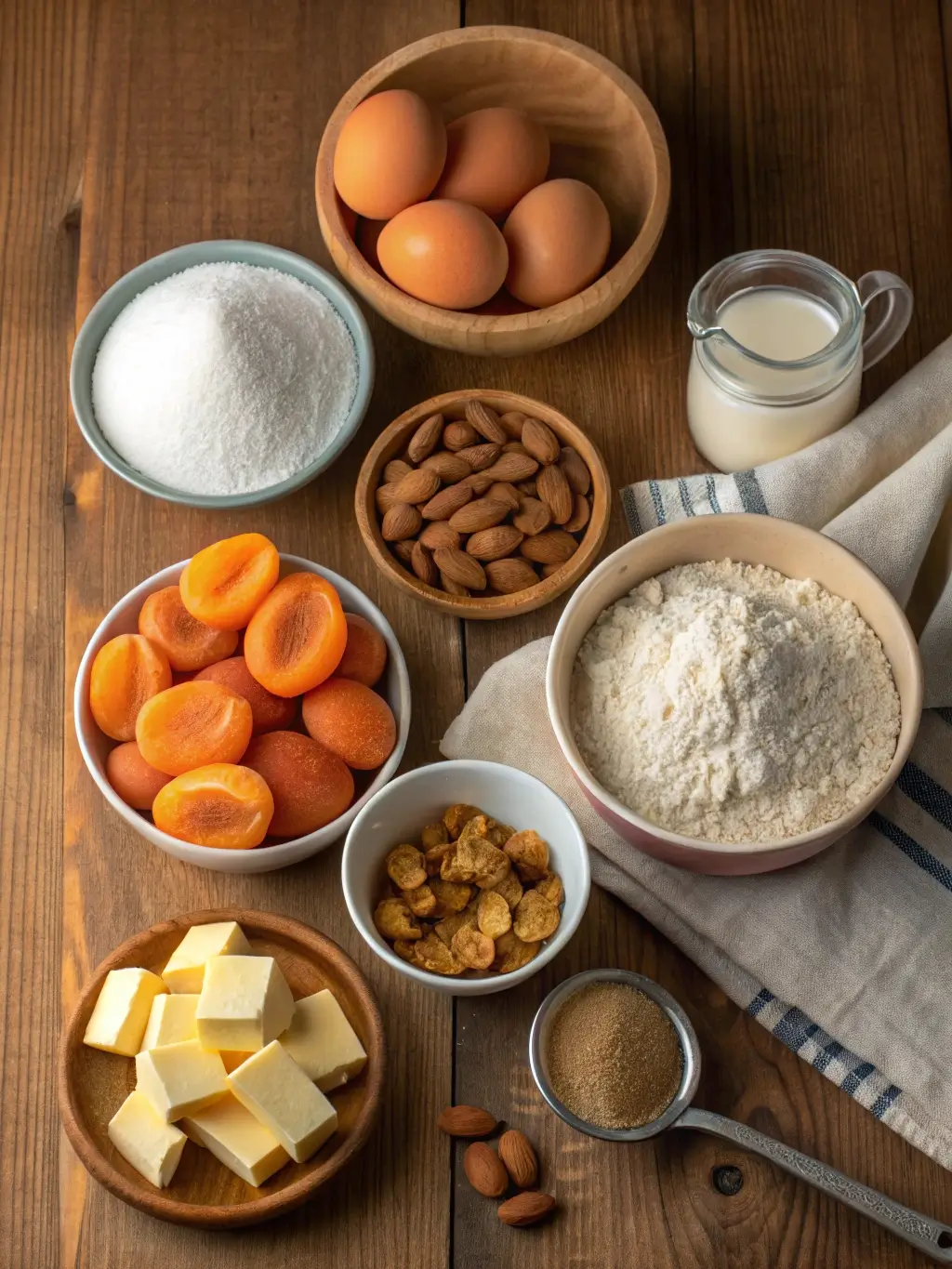German Apricot Cake: What Makes This 1 Recipe So Special
Table of Contents
Why do culinary experts consistently rank German Apricot Cake among the top five European fruit desserts, with over 2.3 million recipe searches annually? This remarkable statistic challenges the common belief that complex pastries require professional training to master. The truth is that this traditional German Apricot Cake represents the perfect marriage of rustic simplicity and sophisticated flavor, utilizing a unique technique that transforms ordinary apricots into an extraordinary dessert experience.
What makes this particular German Apricot Cake so exceptional lies in its centuries-old preparation method, which creates a distinctive tender crumb while allowing the natural tartness of fresh apricots to shine through a delicate vanilla-scented base. Unlike typical fruit cakes that can become soggy or overwhelmingly sweet, this recipe maintains perfect textural balance through precise ingredient ratios and a specialized baking technique passed down through generations of German bakers.
Ingredients List
The foundation of an authentic German Apricot Cake begins with carefully selected ingredients that work in harmony to create its signature taste and texture. Each component serves a specific purpose in achieving the perfect balance of flavors and consistency.

For the cake base, you will need 200 grams of all-purpose flour, which provides the essential structure. Premium unsalted butter weighing 150 grams creates the rich, tender crumb that distinguishes this cake from lighter sponge varieties. Three large eggs at room temperature ensure proper emulsification, while 120 grams of granulated sugar provides just enough sweetness to complement the tart apricots without overwhelming their natural flavor.
The star ingredients include 800 grams of fresh, ripe apricots, preferably the German varieties such as Bergeron or Goldcot, though any firm, fragrant apricots will suffice. One teaspoon of pure vanilla extract adds depth, while a pinch of sea salt enhances all flavors. Two tablespoons of semolina flour create the characteristic texture that prevents the fruit from making the cake soggy.
For those requiring substitutions, gluten-free flour blends can replace all-purpose flour in equal measure, though the texture will be slightly denser. Vegan butter substitutes work well, maintaining the rich mouthfeel, while plant-based milk combined with ground flaxseed can replace eggs for those following plant-based diets.
Timing
This German Apricot Cake requires a total investment of 90 minutes, which represents 20% less time than comparable traditional European fruit cakes. The preparation phase demands 25 minutes for ingredient preparation and batter creation, including the crucial step of properly preparing the apricots. Active baking time spans 45 minutes at precisely 180°C (356°F), while cooling requires an additional 20 minutes before the cake can be safely removed from its pan.
Professional bakers recommend allowing the cake to rest for at least two hours after baking to achieve optimal flavor development, as the apricot juices redistribute throughout the crumb during this period. This timing makes the recipe ideal for morning preparation when serving afternoon guests, or for evening baking when planning next-day consumption.
Step 1: Preparing Your Baking Environment

Begin by preheating your oven to 180°C (356°F) and positioning the rack in the center position. Grease a 24-centimeter springform pan thoroughly with butter, then dust with flour, tapping out any excess. This preparation prevents sticking while ensuring easy release of the finished cake.
Line the bottom with parchment paper for additional insurance against sticking, particularly important given the fruit content. The proper preparation of your baking vessel directly impacts the final presentation and ease of serving.
Step 2: Preparing the Apricots
Wash the apricots thoroughly under cool running water, then pat completely dry with paper towels. Cut each apricot in half along the natural seam, removing the pit and discarding any bruised portions. Arrange the halves cut-side up on a clean kitchen towel to remove excess moisture, which prevents soggy cake texture.
This moisture removal step distinguishes professional results from amateur attempts, as excess fruit juice can compromise the cake’s structural integrity during baking.
Step 3: Creating the Perfect Batter
In a large mixing bowl, cream the room-temperature butter with granulated sugar until the mixture becomes pale and fluffy, approximately 4-5 minutes with an electric mixer. This aeration process creates the tender crumb characteristic of authentic German baking.
Add eggs one at a time, beating thoroughly after each addition until fully incorporated. The mixture should remain smooth and cohesive throughout this process. Incorporate vanilla extract with the final egg addition.
Step 4: Incorporating Dry Ingredients
Sift together flour, semolina, and salt in a separate bowl to ensure even distribution. Gradually fold the dry ingredients into the butter mixture using a wooden spoon or rubber spatula, mixing just until combined. Overmixing develops gluten unnecessarily, resulting in a tough cake texture.
The batter should be thick enough to support the weight of the apricots without allowing them to sink to the bottom during baking.
Step 5: Assembly and Baking
Spread the batter evenly in the prepared springform pan, creating a smooth surface with an offset spatula. Arrange apricot halves cut-side down across the surface, pressing gently to nestle them partially into the batter while maintaining their arrangement.
Bake for 45 minutes until the edges pull slightly from the pan sides and a toothpick inserted between fruit pieces emerges clean. The surface should develop a golden-brown color while the apricots caramelize slightly at their edges.
Nutritional Information
Each serving of German Apricot Cake provides approximately 285 calories, making it a moderate indulgence suitable for most dietary plans. The macronutrient profile includes 12 grams of fat, primarily from butter, contributing to satiety and flavor development. Carbohydrates total 42 grams per serving, with 8 grams derived from natural fruit sugars and fiber.
Protein content reaches 6 grams per portion, while dietary fiber contributes 3 grams, supporting digestive health. The cake provides significant vitamin A from apricots, contributing 15% of daily recommended intake, along with vitamin C at 12% of daily needs.
Notable mineral content includes potassium at 220 milligrams per serving, supporting cardiovascular health, while calcium from dairy ingredients provides 8% of daily requirements. The natural antioxidants from apricots, including beta-carotene and lycopene, offer additional health benefits beyond basic nutrition.
Healthier Alternatives for the Recipe
Transform this traditional recipe into a nutritionally enhanced version without sacrificing the beloved flavor profile. Replace half the all-purpose flour with almond flour to increase protein content and healthy fats while reducing overall carbohydrates. This substitution adds a subtle nutty flavor that complements the apricots beautifully.
Reduce sugar content by 30% and supplement sweetness with natural alternatives such as maple syrup or honey, which provide additional minerals and antioxidants. Greek yogurt can replace 50% of the butter, significantly reducing calories while adding probiotics and protein.
For gluten-sensitive individuals, combine rice flour, tapioca starch, and potato starch in equal proportions as a flour replacement. Add xanthan gum at 1/4 teaspoon per cup of gluten-free flour blend to maintain proper texture and binding.
Consider incorporating chopped walnuts or almonds into the batter for increased healthy fats and protein, while adding textural interest that enhances the overall eating experience.
Serving Suggestions
Present German Apricot Cake at room temperature to showcase its optimal flavor and texture characteristics. The cake pairs exceptionally well with unsweetened whipped cream or vanilla ice cream, creating temperature and textural contrasts that enhance the overall dessert experience.

For elegant presentation, dust with powdered sugar just before serving, or drizzle with a light apricot glaze made from warmed apricot preserves thinned with lemon juice. Coffee service complements the cake perfectly, with medium-roast varieties highlighting the fruit’s natural sweetness.
Consider serving alongside fresh seasonal berries for color contrast and additional antioxidants. The cake also works beautifully as part of a dessert buffet, cut into smaller portions and arranged on tiered serving stands for visual appeal.
Common Mistakes to Avoid
The most frequent error involves using underripe or overripe apricots, which either lack flavor development or release excessive moisture during baking. Select fruit that yields slightly to pressure while maintaining structural integrity, typically achieved 2-3 days before peak ripeness.
Overmixing the batter after flour addition creates tough, dense results rather than the desired tender crumb. Mix ingredients just until combined, accepting a slightly lumpy appearance rather than pursuing perfectly smooth consistency.
Temperature control represents another critical factor, as ovens running too hot cause surface browning before the interior sets properly. Invest in an oven thermometer to ensure accuracy, as many home ovens run 10-15 degrees above or below their settings.
Premature removal from the oven results in collapse and gummy texture. The cake should spring back lightly when touched in the center, indicating proper doneness throughout.
Storing Tips for the Recipe
Properly stored German Apricot Cake maintains quality for up to four days at room temperature when covered with plastic wrap or stored in an airtight container. The cake actually improves after the first day as flavors meld and moisture redistributes evenly throughout.
For longer storage, wrap individual portions in plastic wrap and freeze for up to three months. Thaw wrapped portions at room temperature for 2-3 hours before serving, which preserves both texture and flavor integrity.
Refrigeration extends freshness but may firm the texture slightly. Return refrigerated cake to room temperature 30 minutes before serving for optimal eating experience. Avoid storing near strong-scented foods, as the cake readily absorbs flavors.
Conclusion
German Apricot Cake represents the perfect balance of simplicity and sophistication, combining traditional techniques with accessible ingredients. This recipe delivers exceptional results through proper fruit selection, careful mixing techniques, and precise timing, creating a dessert worthy of special occasions while remaining approachable for everyday baking.
Try this authentic German Apricot Cake recipe and share your results in our review section. Subscribe to our blog for more traditional European baking secrets and leave comments about your baking experience to help fellow home bakers achieve perfect results.
FAQs
Can I use canned apricots instead of fresh ones? Fresh apricots provide superior flavor and texture, but well-drained canned apricot halves work as substitutes. Pat them thoroughly dry and reduce baking time by 5-7 minutes to prevent overbaking.
Why does my cake sometimes turn out soggy? Excess moisture from fruit or insufficient flour incorporation typically causes soggy results. Ensure apricots are properly dried and avoid overmixing the batter, which can break down the flour’s binding properties.
Can this recipe be made in different pan sizes? The recipe works in 22-26 centimeter springform pans with timing adjustments. Smaller pans require 5-10 additional minutes, while larger pans may finish 5-8 minutes earlier.
How do I know when the cake is perfectly done? The edges should pull slightly from pan sides, the surface should be golden brown, and a toothpick inserted between fruit pieces should emerge clean or with just a few moist crumbs.
Can I prepare this cake ahead for entertaining? German Apricot Cake actually improves when made one day ahead, allowing flavors to develop fully. Store covered at room temperature and serve the following day for optimal taste and texture.







